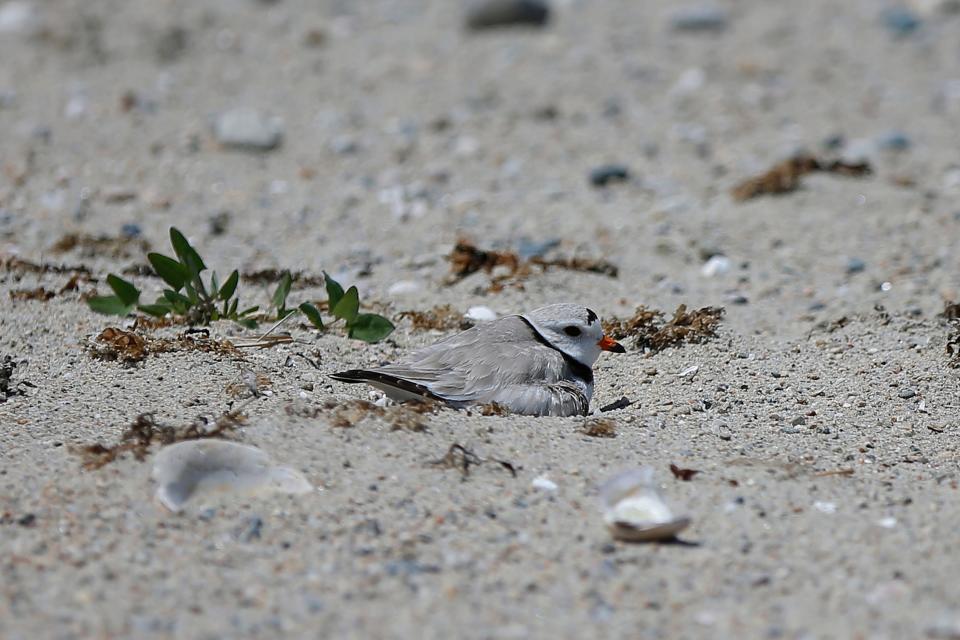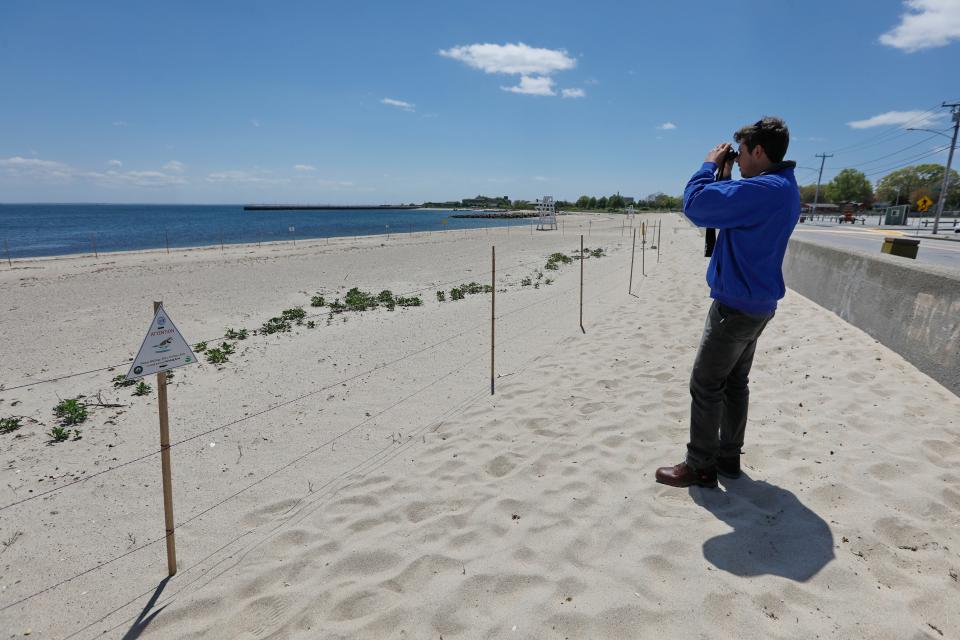Piping plovers return to East Beach in New Bedford again. Here's why people are watching
The pair of piping plovers have returned to New Bedford’s East Beach and are getting ready to hatch some eggs.
An endangered species, New Bedford Conservation Agent Chance Perks watches over the plovers with help from two paid Massachusetts Audubon Society monitors under contract with the city and with the help of neighborhood volunteers.
While watching over the shore birds nesting on East Beach isn’t part of his normal duties, and kept him busy last year, Perks said he feels responsible for them, not only because it’s the law, but also because he’s excited about their return to New Bedford to breed.
Last year was the first year that they laid eggs and hatched.
“That was a big deal,” he said. “It takes a lot of work, but it was a big success. In the beginning, it’s being prepared for them showing up in April or May, usually April, watching for the breeding pair and watching their behavior to see if they’re doing their courtship behavior.”
Perks said they have a couple of little dances that they do, they have specific breeding calls and it’s also demonstrated in the way they fly around. The males will start their “scrapes,” basically scraping several shallow depressions into the ground, and the female will choose one in which to lay their eggs.

Piping plover females choose mates by their 'scrapes'
Perks, who has been the conservation agent for two and a half years, said he’s excited that it was not a one-time only occurrence.
The area of East Beach where the birds are under surveillance has been closed to the public to give them space.
State and federal guidelines require that they put up stakes and strings to protect a radius around the scrapes to delineate where the nests are located.

After that it’s about observing them and keeping people away from them and making sure the signs are in place and the stakes stay up. During the monitoring phase, they need to be on site.
“All it takes is one person with a dog off leash, someone flying a kite, a football game gone awry or trash blowing in to scare the birds off the nests,” he said. “Depending on how that goes, that could land the city or a specific resident in hot water in addition to hurting the birds.”
Unusual visitor: After a busy morning in New Bedford, SouthCoast's black bear took a nap in Acushnet.
Why piping plovers return to the same nesting areas
Plovers have what is called site fidelity. They may migrate down to Florida or the Gulf of Mexico, they fly right back to almost within a foot of where the nest was the previous year to lay their eggs again.
He expects that more plovers will make their nests in the areas due to this recent success because the species is growing in number, and Massachusetts is considered to be a stronghold with more breeding pairs in the state than anywhere else on the Eastern Seaboard.
So far, there is one breeding pair that they know of, but not every inch of the city’s beaches have been combed looking for them.
He said one breeding pair will lay about four eggs, and he’s hopeful three or four chicks will be able to survive the season. The females will It’s a tough environment, and they have a very narrow ecological niche. The birds will often hunker down or seek shelter nearby in bad weather, and the mother will stay on the eggs while she’s incubating.
What's happened here: Coastal ecologist says handling of piping plovers is a major Massachusetts success story
They may be small, but they are hearty, resilient birds, but he said there needs to be a balance between residents and birds in a high population area like New Bedford.
Perks said plovers survive by hiding in plain sight. What’s interesting, he said, is that their predators including seagulls, crows and raccoons are intelligent and science has shown that they watch human behavior such as pointing at a nest. He also asks that people not leave food for the predators.
“Try not to draw attention to them, the seagulls believe it or not are watching,” he said.
They are seeing a general trend of species coming back to the area. The return of another bird, the American oyster catchers, and the return of the horseshoe crab are two other species classified as being of special concern that he wants to see more of on New Bedford’s beaches.
“My predecessor while she was in this position had just started noticing the plovers come around here and in surrounding communities, but we weren't successful in actually getting them to breed in New Bedford,” he said. We were one of the last voids on the map.”
Perks anticipates that the eggs will hatch around Memorial Day weekend after a 25 to 28-day incubation, and they hatch within a day or two of each other. It’s then another 25 days before they are ready to fly away.
He’s hopeful that the plovers will be on their way out of New Bedford by the busy Fourth of July holiday with all the fireworks and activity.
He said he’s appreciative of all the community support and invites anyone with questions to reach out to the Environmental Stewardship site on the city’s website.
Standard-Times staff writer Kathryn Gallerani can be reached at kgallerani@gannett.com. Follow her on Twitter: @kgallreporter.
This article originally appeared on Standard-Times: Piping plovers on East Beach, New Bedford MA: Here's why we watch them

